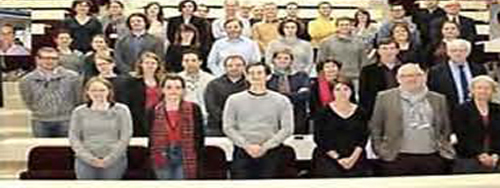Degenerative and vascular cognitive discorders

Presentation
This team, made up of clinical and pre-clinical researchers, is multidisciplinary. It is located at the interface between neurology, pharmacology and imaging. The research project is focused on the translational, transnosographic and multimodal study of cognitive disorders associated with degenerative processes or neurovascular lesions, starting from the observation that the mechanisms are entangled.
- FERROPTOSIS AND NEURONAL DEATH / MOLECULAR AND PHARMACOLOGICAL MECHANISMS, EVALUATION OF THERAPEUTIC STRATEGIES
Project
Neurodegenerative diseases are multifactorial but are all characterized by the regulated death of neurons which, depending on their location, have variable clinical expressions. For a long time, the dogma of a single regulated death by apoptosis limited research. Among other forms, ferroptosis has been described recently and is characterized by iron dependence and an accumulation of peroxidized lipids at the membrane level leading to its rupture. We have demonstrated in vitro and in vivo that human dopaminergic neurons are particularly sensitive to ferroptosis and that specific inhibitors such as Ferrostatin-1, Liproxstatin-1 and iron chelators are potent neuroprotective agents.
We are now working on alpha-synuclein, lipid metabolism and mitochondrial energy metabolism linkages while developing specific biomarkers of target engagement, drug discovery and large therapeutic trials.
Team: Jean Christophe Devedjian, David Devos, Caroline Moreau, Anne Sophie Rolland, Pauline Guyon, Charlotte Laloux, Flore Gouel, Kelly Timmerman, Cédrick Lachaud, Aurélie Jonneaux, Maud Petrault, Laura Mahoney-Sanchez, Hind Bouchaoui, Karim Belarbi, Marie Amandine Bonte, Emma Theerens, Florent Auger, Clemence Leboullenger, Renaud Lopes, Nacim Betrouni, Jean Pierre Pruvo, Gregory Kuchcinski, Romain Viard, Véronique Danel Luc Defebvre, Dominique Deplanque, Régis Bordet
Lille Collaborations:
UMRS 1172 Vincent Huin (A&T team), Patricia Melnyk, Séverine Ravez, Jamal El Bakali (BBC team)
ULR4483 - IMPact of the Chemical Environment on Health (IMPECS) : Guillaume Garçon
UMR9020 – UMR-S 1277: Philippe Marchetti, Jérome Kluza
International collaborations:
ALBORADA Drug Discovery Institute, University of Cambridge, UK: James Duce
Melbourne Dementia Research Centre, The Florey Institute of Neuroscience & Mental Health, The University of Melbourne, Australia: Ashley Bush, Scott Ayton
University of Munich Helmholtz Zentrum Muenchen Germany: Marcus Conrad
University of Ulm Germany: Markus Otto, Patrick Oeckl, Deniz Yilmazer-Hanke, Volker RascheA&M Della Pergola Chair in Life Sciences, Alexander Silberman Institute of Life Sciences, Hebrew University of Jerusalem, Israel 91904: Ioav Cabantchik
Consortium Européen FAIRPARK-II https://www.fairpark2.eu/
Industrial collaborations with contracts:
Iron chelators : Apopharma/Chiesi, Alterity, Abfero
Antiferroptotics : PTC Therapeutics
Labels / funding:
- 3 PHRC-Nationaux dont FAIR-ALS-II Conservative Iron Chelation by Deferiprone as a Disease-modifying Strategy for Amyotrophic Lateral Sclerosis using a multicentre, Parallel-group, Placebo-controlled, Randomized Clinical Trial on 240 patients Protocol ID: 2017-003763-35; ClinicalTrials.gov: NCT03293069.
- Patient associations (ARSLA, Parkinson France)
- European Commission Horizon 2020, grant agreement N° 633190 Conservative iron chelation as a disease-modifying strategy in Parkinson’s disease: a multicentre, parallel-group, placebo-controlled, randomized clinical trial of deferiprone (FAIR-PARK-II); Protocol ID: 2015_22; Clinical trial: NCT02655315
- European funds for preclinical research of excellence on neurodegenerative diseases: Network of Centres of Excellence in Neurodegeneration (CoEN) 2017-2018: Pathfinder III: Is prion like propagation of alpha synuclein aggregation associated with a ferroptotic cell death; PRION-IRON
- European Commission Horizon 2020 Eurostar for preclinical research: PD-IRONSYN, Novel Parkinson's Disease therapy targeting iron-related cell death and alpha synuclein aggregation
Highlights
3 European Commission grants (H2020) including 2 preclinical and 1 clinical trial
- Centres of Excellence in Neurodegeneration: Is prion like propagation of synuclein aggregation associated with ferroptosis
- Eurostar: Novel PD therapy targeting ferroptosis, and alpha synuclein aggregation
- Clinical trial: Conservative iron chelation as a disease-modifying strategy in PD: a multicentre, parallel-group, placebo-controlled, randomized clinical trial of deferiprone
https://www.fairpark2.eu/
New biomarkers and new treatments: Iron overload and massive lipid peroxidation offer new biomarkers by imaging and biology that allow to better define populations with a ferroptotic process and to monitor therapeutic efficacy to facilitate the development of new chelators (Abfero, Alterity) and antiferroptotics (PTC Therapeutics) or deferiprone in ALS (FAIRALS study).
Drug discovery: Enrichment with polyunsaturated fatty acids sensitizes ferroptose. Inhibition of enzymes involved in lipid metabolism (ACSL4 and LOX15) prevents lipid peroxidation and cell death. The variation in levels of ∝-synuclein modulates sensitivity to ferroptosis but not to other forms of cell death offering new therapeutic targets (LOX15 inhibitors, PTC Therapeutics) and new molecules (Lille and Cambridge co-development).
Publications
Ferroptosis, a newly characterized form of cell death in Parkinson's disease that is regulated by PKC. Do Van B, Gouel F, Jonneaux A, Timmerman K, Gelé P, Pétrault M, Bastide M, Laloux C, Moreau C, Bordet R, Devos D, Devedjian JC. Neurobiol Dis. 2016 doi: 10.1016/j.nbd.2016.05.011.
Ferroptosis and its potential role in the physiopathology of Parkinson's Disease. Mahoney-Sanchez L, Bouchaoui H, Ayton S, Devos D, Duce JA, Devedjian JC. Prog Neurobiol. 2021 doi: 10.1016/j.pneurobio.2020.101890.
Iron as a therapeutic target for Parkinson's disease. Moreau C, Duce JA, Rascol O, Devedjian JC, Berg D, Dexter D, Cabantchik ZI, Bush AI, Devos D. Mov Disord. 2018 doi: 10.1002/mds.27275.
